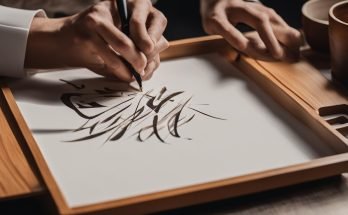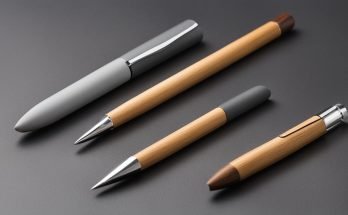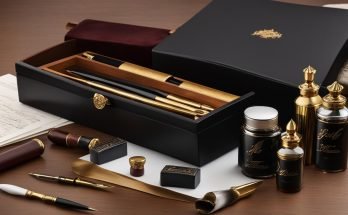Handmade Calligraphy Paper: Discover the Unmatched Elegance Today!
Welcome to the world of calligraphy! As you embark on your calligraphy journey, one thing you’ll quickly discover is the importance of using the right tools and materials. While there are various calligraphy supplies and art supplies available, one item that should not be overlooked is handmade calligraphy paper.
Handmade calligraphy paper is specifically designed to enhance your calligraphy experience and elevate your art. Its unique qualities make it the perfect surface for different calligraphy tools, whether you prefer brush pens, dip pens, or markers. Using custom calligraphy paper ensures a smooth and enjoyable writing experience, helping you achieve optimal results.
Key Takeaways:
- Handmade calligraphy paper is essential for achieving the best results in calligraphy.
- The right paper prevents ink bleeding, feathering, and nibs catching on fibers.
- Choosing the appropriate handmade calligraphy paper enhances your art
- Understanding different paper weights helps in selecting the right paper
- Categories of calligraphy paper include card stock, bond paper, laserjet paper, and watercolor paper
Understanding the Importance of Paper Weight
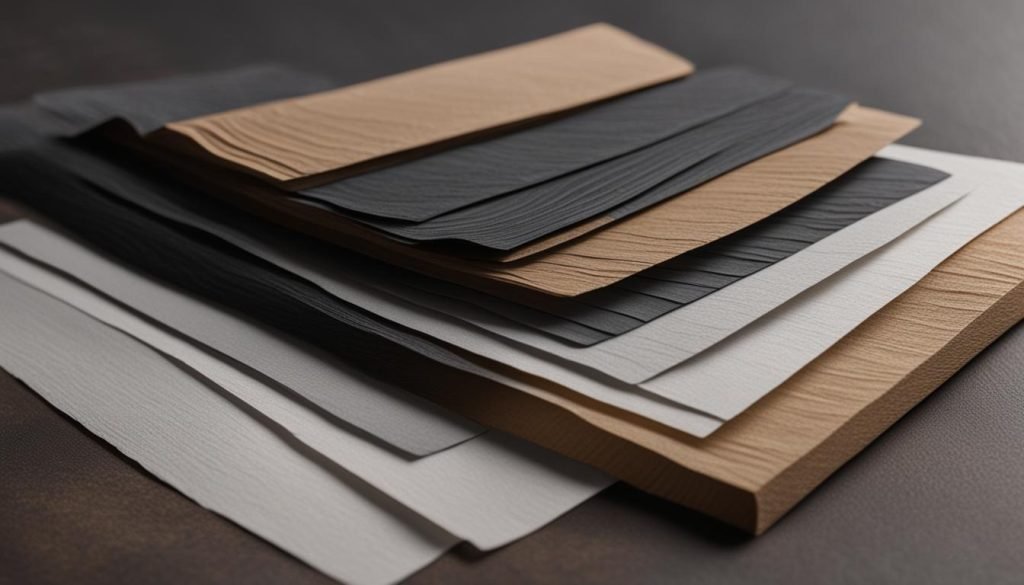
Paper weight is a crucial factor to consider when selecting handmade calligraphy paper. It directly affects the thickness, density, and overall performance of the paper. Understanding paper weight is essential for achieving optimal results and enhancing your artistic expression in calligraphy.
In the United States, paper weight is measured in pounds, while globally, it is expressed in grams per square meter (GSM). This measurement determines the durability, ink absorption, and smoothness of the paper. Choosing the right weight for your calligraphy projects is key to ensuring a seamless writing experience and achieving the desired artistic outcome.
To better understand the concept of paper weight, let’s compare the two measurement systems:
| Paper Weight Measurement | Description |
|---|---|
| Pounds (lb) | Commonly used in the United States, paper weight is expressed in pounds. The higher the weight, the thicker and denser the paper. It offers better ink control and prevents ink bleeding. Lighter weights are suitable for practice and everyday use, while heavier weights are ideal for professional projects and special occasions. |
| Grams per Square Meter (GSM) | Globally recognized, GSM measures the weight of paper per square meter. The higher the GSM, the denser and thicker the paper. A high GSM indicates a more substantial and durable surface for calligraphy. It offers enhanced ink absorption and prevents feathering. |
By understanding paper weight and its impact on calligraphy, you can make informed choices when selecting handmade calligraphy paper. Whether you’re a beginner or an experienced calligrapher, choosing the right paper weight will help you achieve optimal results, enhance your artistic expression, and elevate your calligraphy to a whole new level.
Continue reading to explore different categories of calligraphy paper and discover the best options for calligraphy practice and professional projects.
Different Categories of Calligraphy Paper
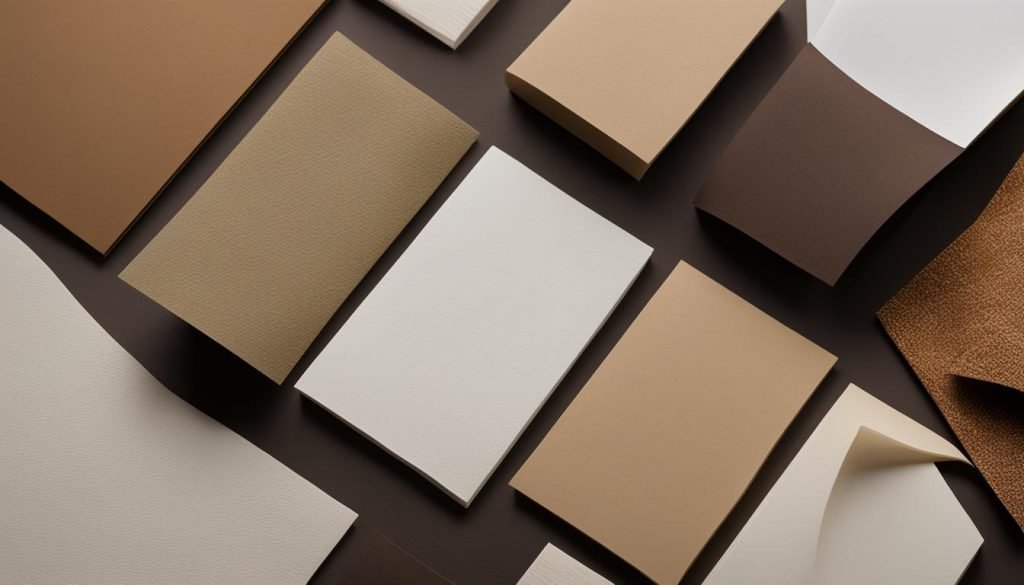
When it comes to calligraphy, choosing the right paper is essential for achieving beautiful results. There are different categories of calligraphy paper, each with its own specifications and suitability for various purposes.
Card Stock
Card stock, also known as “cover” paper, is a heavyweight paper that is perfect for creating sturdy and durable calligraphy projects. It is commonly used for making greeting cards, invitations, and other DIY crafts. The weight of card stock is determined by a standard ream size of 20″ x 26″. Its thickness and smooth finish make it ideal for calligraphy, as it prevents ink bleeding and provides a crisp writing surface.
Laserjet Paper
Laserjet paper, also known as “bond” or “writing” paper, is a versatile option for calligraphy. It is commonly used for printing documents and is suitable for calligraphy practice and projects that require a smooth writing experience. Laserjet paper has a standard ream size of 17″ x 22″ and is available in various weights. It offers excellent ink control and is compatible with different calligraphy tools such as dip pens and brush pens.
Watercolor Paper
If you enjoy combining calligraphy with watercolor painting, watercolor paper is a must-have. This specialized paper is designed to withstand the wetness of watercolors without warping or deteriorating. Watercolor paper comes in different weights, such as 90 lb., 140 lb., and 300 lb., providing options for different painting techniques and effects. Its texture and absorbency allow the ink to bond effectively with the paper, resulting in vibrant and long-lasting colors.
Calligraphy Paper Categories and Specifications
| Category | Standard Ream Size | Recommended Use |
|---|---|---|
| Card Stock (Cover Paper) | 20″ x 26″ | Invitations, greeting cards, DIY crafts |
| Laserjet Paper (Bond/Writing Paper) | 17″ x 22″ | Calligraphy practice, smooth writing experience |
| Watercolor Paper | Varies (e.g., 90 lb., 140 lb., 300 lb.) | Calligraphy combined with watercolor painting |
Understanding the different categories of calligraphy paper allows you to make informed choices when selecting the right paper for your specific projects. Whether you’re creating invitations, practicing your calligraphy skills, or exploring the artistic possibilities of watercolor, choosing the appropriate paper will contribute to the success and visual impact of your work.
Choosing the Best Papers for Calligraphy Practice
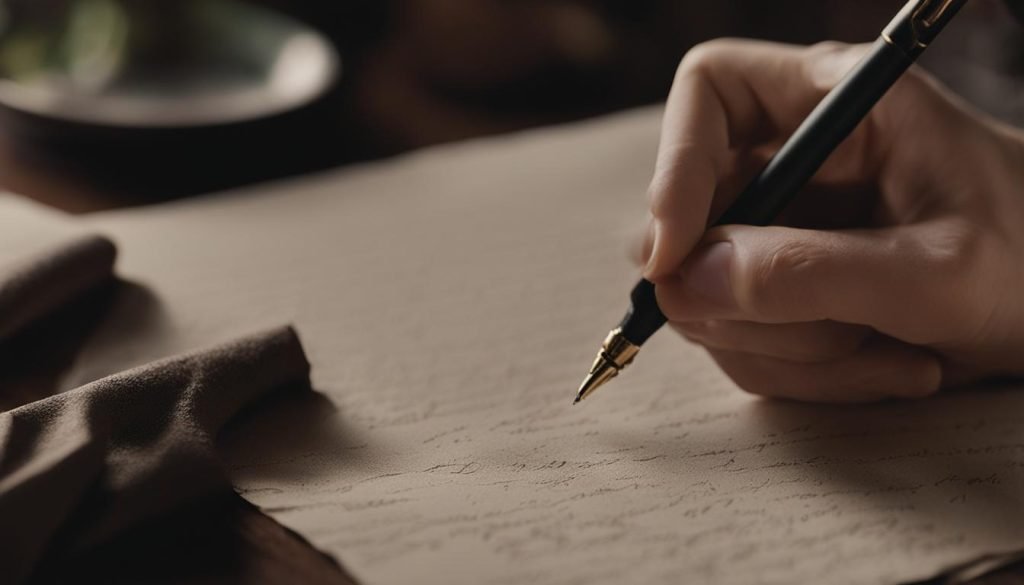
When it comes to calligraphy practice, selecting the right paper is essential for honing your skills and achieving optimal results. The best calligraphy practice paper should possess certain qualities that enhance your writing experience and ensure precise ink control. Here are some factors to consider:
Smoothness: Nib-Friendly Surfaces
In calligraphy, smooth papers are a game-changer. They allow your nib to glide effortlessly, resulting in clean and smooth lines. Look for papers with a velvety texture that minimizes friction, enabling you to create beautiful letterforms.
Dense Fiber Composition: Ink Stability
Opt for papers made with dense fibers as they contribute to ink stability. These papers prevent ink bleed and spiderwebbing, ensuring that your calligraphy maintains its crispness and clarity. The densely packed fibers help keep the ink in place, allowing for precise strokes.
32# HP Premium Laserjet Paper: A Top Choice
One of the best papers for calligraphy practice is the 32# HP Premium Laserjet paper. This paper offers an ideal surface for worksheets and beginners. It strikes the perfect balance between smoothness and ink control, allowing you to practice your strokes with ease and precision.
“The right practice paper can make a world of difference in your calligraphy journey. Choose papers that are smooth, have dense fibers, and prevent ink bleed for a truly enjoyable and productive practice session.”
By investing in the best calligraphy practice paper, you can enhance your skills and refine your technique. Smooth papers and dense fiber compositions ensure a smooth writing experience and prevent any ink-related issues that may hinder your progress. The 32# HP Premium Laserjet paper, in particular, offers an excellent platform for calligraphy practice.
Selecting Papers for Professional Calligraphy
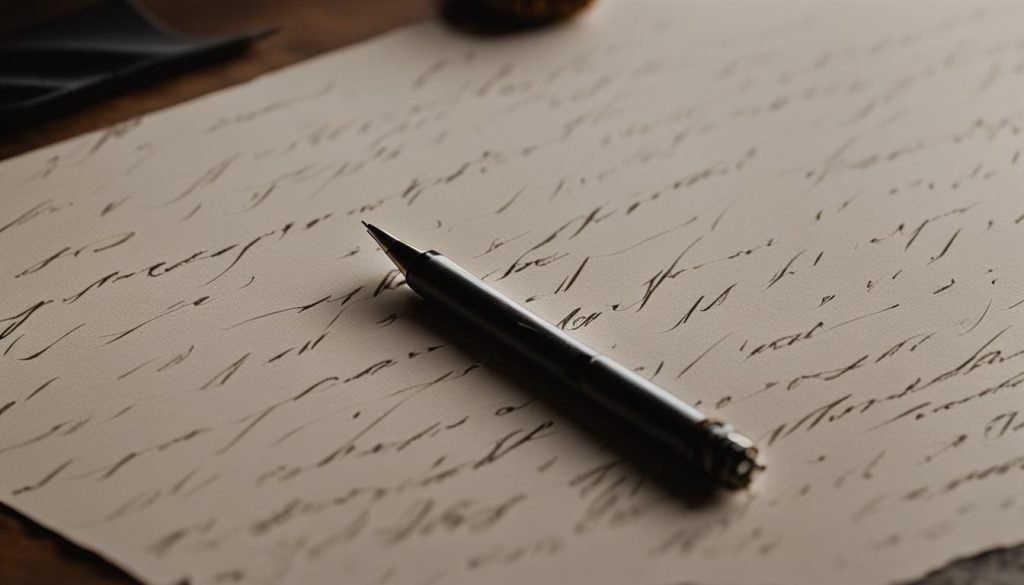
When it comes to professional calligraphy projects, using high-quality papers is essential to achieve exceptional results. The right paper should be sturdy, have a high fiber density, and prevent any ink bleeding. These characteristics not only provide a luxurious feel but also ensure crisp and clean lines in your calligraphy work.
For wedding invitations and other important projects, several papers are highly recommended:
- Strathmore 400 Series 80 lb. Drawing Paper: This paper offers both durability and versatility, making it suitable for various calligraphy techniques. With its smooth surface, it provides an excellent writing experience and allows your ink to flow smoothly.
- Strathmore 400 Series 140 lb. Watercolor Paper: This heavyweight paper is perfect for calligraphers who want to add a touch of watercolor to their creations. With its ability to handle water-based media, it offers unique opportunities for artistic expression.
- Indian Cotton Paper Co. Handmade Paper: This handmade paper is renowned for its exceptional quality and luxurious texture. Made from 100% cotton, it provides a beautiful surface that enhances the elegance of any calligraphy design.
With these professional calligraphy papers, you can confidently create stunning pieces that exude beauty and sophistication. Whether you’re working on wedding invitations, personalized stationery, or special art projects, the right paper choice will elevate your calligraphy to new heights.
Choosing the Right Envelopes for Calligraphy
When it comes to calligraphy, the quality of your envelopes is just as important as the paper you use. To prevent ink bleed and ensure a professional appearance, it’s crucial to choose high-quality and heavy envelopes.
Thin and low-quality envelopes, often found in craft stores, are not suitable for calligraphy. These envelopes are more prone to ink bleeding, which can ruin the look of your beautifully crafted calligraphy.
Instead, opt for envelopes from reputable sources that specialize in high-quality stationery. Some top envelope sources for calligraphy include:
- Cards & Pockets
- Indian Cotton Paper Co.
- Crane & Co.
- Paper Source
- Envelopes.com
These sources offer a wide range of envelope options suitable for calligraphy, ensuring that your work is beautifully presented and makes a lasting impression.
By choosing envelopes from these reputable sources, you can be confident in the quality and durability of your envelopes, preventing ink bleed and ensuring your calligraphy envelopes look professional and elegant.
| Envelope Source | Key Features |
|---|---|
| Cards & Pockets | Wide selection of high-quality envelopes |
| Indian Cotton Paper Co. | Handmade envelopes with unique textures |
| Crane & Co. | Classic and elegant envelopes |
| Paper Source | Variety of colors and envelope sizes |
| Envelopes.com | Customizable envelopes in various styles |
Preventing Ink Bleed with High-Quality Envelopes
“Choosing the right envelopes is crucial for calligraphy. High-quality envelopes prevent ink bleed and ensure a professional appearance. Don’t compromise on the quality of your envelopes.”
With these high-quality envelopes, you can confidently send out your calligraphy creations, whether it’s wedding invitations, thank-you notes, or special occasion cards.
Remember, the details matter in calligraphy, and the choice of envelopes is no exception. Invest in high-quality envelopes to complement your stunning calligraphy, and make a lasting impression on recipients.
Find the Perfect Paper for Recreational Drawing
If you enjoy recreational drawing alongside your calligraphy practice, it is crucial to find the perfect paper for various drawing mediums. A sketchbook with a minimum of 70 lb. paper weight is recommended, as it provides a good balance between preventing ink spiderwebbing and allowing smooth line work.
One highly recommended option is the Shinola sketchbook, which contains 100 lb. paper suitable for a variety of mediums, including pencil and light watercolor. The quality of the paper ensures that your drawings look vibrant and professional.
When selecting paper for recreational drawing, it is important to consider the ideal paper weight that suits your drawing style and preferred mediums. The Shinola sketchbook, with its 100 lb. paper weight, provides the perfect balance for creating detailed pencil sketches or adding light watercolor washes to your artwork.
With the Shinola sketchbook, you can confidently experiment with different mediums and techniques without worrying about the paper’s quality. Whether you prefer the precision of a pencil or the fluidity of watercolor, the Shinola sketchbook’s smooth surface and heavyweight paper will enhance your drawing experience.
Investing in a quality sketchbook like the Shinola sketchbook not only ensures the longevity of your drawings but also allows you to showcase your artwork with pride. Whether you’re drawing for personal enjoyment or considering sharing your creations with others, the right paper can make all the difference.
Conclusion
Handmade calligraphy paper is a crucial element in the world of calligraphy art. By carefully selecting the right paper weight, understanding the different categories of paper, and choosing appropriate papers for practice and professional projects, you can greatly enhance your calligraphy experience and achieve optimal results. Whether you’re just starting or a seasoned calligrapher, investing in high-quality handmade calligraphy paper is essential for a smooth writing experience, preventing ink issues, and presenting a professional appearance.
When you choose the perfect handmade calligraphy paper, you create a solid foundation for your artwork. The right paper weight ensures that your ink flows smoothly, while the right category of paper offers the ideal surface for your calligraphy tools. Additionally, selecting the best paper for your practice and professional projects allows you to create crisp, clean, and beautiful lines.
Remember, your calligraphy journey is unique, and finding the right handmade calligraphy paper for your specific needs is key. Take the time to explore different options and consider factors such as paper weight, categories, and the desired appearance of your final piece. With the right handmade calligraphy paper, you’ll elevate your art and unleash your creativity with confidence and grace.
FAQ
Why is handmade calligraphy paper important?
Handmade calligraphy paper is essential for achieving the best results in calligraphy. It prevents ink bleeding, feathering, and nibs catching on fibers, while providing the perfect surface for different calligraphy tools.
How is paper weight important in calligraphy?
Paper weight determines the thickness and density of the paper, affecting its performance in calligraphy. Understanding paper weight is crucial in selecting handmade calligraphy paper, as it determines durability, ink absorption, and smoothness.
What are the different categories of calligraphy paper?
Calligraphy paper categories include card stock (cover paper), bond or writing paper, and watercolor paper. Each category has its own standard ream size that determines weight and suitability for different purposes.
What papers are recommended for calligraphy practice?
Smooth and dense fiber papers are recommended for calligraphy practice, as they prevent ink bleed and provide a smooth writing experience. One top choice is the 32# HP Premium Laserjet paper.
What papers are suitable for professional calligraphy?
Sturdy papers with high fiber density and no ink bleeding are ideal for professional calligraphy projects. Some top choices include Strathmore 400 Series 80 lb. drawing paper, Strathmore 400 Series 140 lb. watercolor paper, and Indian Cotton Paper Co. handmade paper.
What kind of envelopes should be used for calligraphy?
High-quality and heavy envelopes should be used for calligraphy to prevent ink bleeding and ensure a professional appearance. Reputable sources for envelope options include Cards & Pockets, Indian Cotton Paper Co., Crane & Co., Paper Source, and Envelopes.com.
What paper is recommended for recreational drawing alongside calligraphy practice?
A sketchbook with a minimum of 70 lb. paper weight is recommended for recreational drawing alongside calligraphy practice. The Shinola sketchbook, with 100 lb. paper, is highly recommended for its quality and versatility.
Why is choosing the right handmade calligraphy paper important?
Choosing the right handmade calligraphy paper enhances the quality and success of calligraphy art, ensuring a smooth writing experience, preventing ink issues, and creating a professional appearance.


